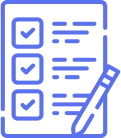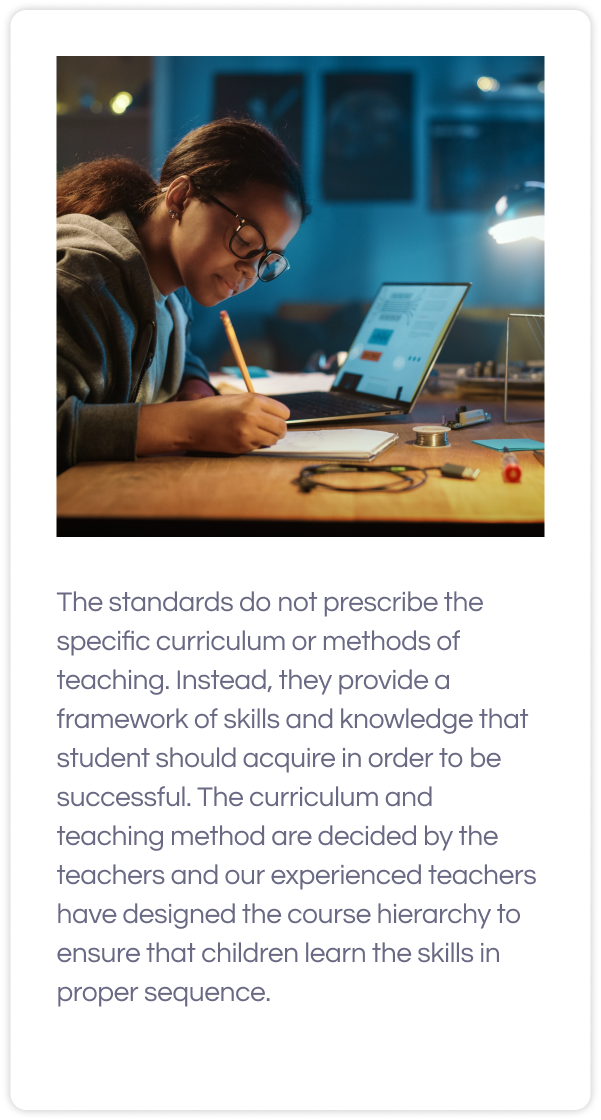Geometry Course Details
Building unique learning experiences with the courses mapped to the national standards.
Course Metrics
-
 Skills
170
Skills
170 -
 Tutorials
338
Tutorials
338 -
 Video Lessons
58
Video Lessons
58 -
 Examples
888
Examples
888 -
 Free Response Questions
6238
Free Response Questions
6238 -
 Multiple Choice Questions
1313
Multiple Choice Questions
1313 -
 Online Practice Assessments
72
Online Practice Assessments
72 -
 Graded Assessments
74
Graded Assessments
74
Overview
The Geometry curriculum at Educo Learning Center (ELC) focuses on essential topics aligned with the Common Core standards. In Geometry, students delve into foundational concepts such as congruence, similarity, and the properties of geometric figures. They explore transformations like rotations and reflections, proving theorems through geometric methods and algebraic reasoning. The curriculum emphasizes applications of geometry in real-world scenarios, including measurement of geometric figures, calculation of areas and volumes, and geometric constructions using tools like compasses and straightedges. By mastering these skills, students build a solid understanding of geometric principles and develop critical thinking abilities essential for solving complex problems across various disciplines.
At Educo Learning Center, our Geometry curriculum integrates dynamic visualizations and guided explorations to enhance both symbolic reasoning and spatial understanding. Students actively investigate core Geometry concepts aligned with the Common Core standards, such as congruence, similarity, circles, and geometric constructions. Our approach emphasizes practical applications, enabling students to apply geometric principles to real-world scenarios. Adaptive exercises and comprehensive practice tests ensure continuous assessment, offering immediate feedback to track progress effectively and support each student's learning journey.
"I Can" Statements For Math Geometry
Mathematics | High School—Geometry
| Standard | HSG-CO.A.1 |
|---|---|
| Standard Description | 1. Know precise definitions of angle, circle, perpendicular line, parallel line, and line segment based on the undefined notions of point, line, distance along a line, and distance around a circular arc. |
| Online Corse Hierarchy | 1.1 |
| I Can Statements |
I can understand the basic terms used in geometry, like angles, line, line segments, point, parallel and perpendicular lines. I can measure line segments. |
| Standard | HSG-CO.A.2 |
|---|---|
| Standard Description | 2. Represent transformations in the plane using, e.g., transparencies and geometry software; describe transformations as functions that take points in the plane as inputs and give other points as outputs. Compare transformations that preserve distance and angle to those that do not (e.g., translation versus horizontal stretch). |
| Online Corse Hierarchy | 1.2, 1.4, 1.5 |
| I Can Statements |
I can define polar coordinates and convert polar to rectangular coordinates and vice-versa. I can define transformations – reflections, rotations, translations, and dilations. |
| Standard | HSG-CO.A.3 |
|---|---|
| Standard Description | 3. Given a rectangle, parallelogram, trapezoid, or regular polygon, describe the rotations and reflections that carry it onto itself. |
| Online Corse Hierarchy | 1.4, 1.5 |
| I Can Statements | I can define reflections and rotations in polygons. |
| Standard | HSG-CO.A.4 |
|---|---|
| Standard Description | 4. Develop definitions of rotations, reflections, and translations in terms of angles, circles, perpendicular lines, parallel lines, and line segments. |
| Online Corse Hierarchy | 1.6 |
| I Can Statements | I can define the composition of isometries. |
| Standard | HSG-CO.A.5 |
|---|---|
| Standard Description | 5. Given a geometric figure and a rotation, reflection, or translation, draw the transformed figure using, e.g., graph paper, tracing paper, or geometry software. Specify a sequence of transformations that will carry a given figure onto another |
| Online Corse Hierarchy | 1.3 |
| I Can Statements | I can define symmetry and rotational symmetry. |
| Standard | HSG-CO.B.6 |
|---|---|
| Standard Description | 6. Use geometric descriptions of rigid motions to transform figures and to predict the effect of a given rigid motion on a given figure; given two figures, use the definition of congruence in terms of rigid motions to decide if they are congruent. |
| Online Corse Hierarchy | 4.1 |
| I Can Statements | I can use the definition of congruence in terms of rigid motions to decide if they are congruent. |
| Standard | HSG-CO.B.7 |
|---|---|
| Standard Description | 7. Use the definition of congruence in terms of rigid motions to show that two triangles are congruent if and only if corresponding pairs of sides and angles are congruent. |
| Online Corse Hierarchy | 4.1 |
| I Can Statements | I can use the definition of congruence in terms of rigid motions to show that two triangles are congruent if and only if corresponding pairs of sides and angles are congruent. |
| Standard | HSG-CO.B.8 |
|---|---|
| Standard Description | 8. Explain how the criteria for triangle congruence (ASA, SAS, and SSS) follow from the definition of congruence in terms of rigid motions. |
| Online Corse Hierarchy | 4.1, 4.2 |
| I Can Statements | I can define different criteria of triangle congruence (ASA, SAS, SSS, and RHS) |
| Standard | HSG-CO.C.9 |
|---|---|
| Standard Description | 9. Prove theorems about lines and angles. Theorems include: vertical angles are congruent; when a transversal crosses parallel lines, alternate interior angles are congruent, and corresponding angles are congruent; points on a perpendicular bisector of a line segment are exactly those equidistant from the segment's endpoints. |
| Online Corse Hierarchy | 2.1, 2.2, 2.3 |
| I Can Statements |
I can define types of angles and angle measurements. I can define special angle pairs. I can define parallel lines, transversal, and angle pairs. I can prove theorems about lines and angles. |
| Standard | HSG-CO.C.10 |
|---|---|
| Standard Description | 10. Prove theorems about triangles. Theorems include: measures of interior angles of a triangle sum to 180°; base angles of isosceles triangles are congruent; the segment joining midpoints of two sides of a triangle is parallel to the third side and half the length; the medians of a triangle meet at a point. |
| Online Corse Hierarchy | 3.1, 3.2, 3.3 |
| I Can Statements |
I can define triangles and their properties. I can define centroid, orthocenter, circumcenter, and incenter and theorems about triangles. I can define inequalities in a triangle. |
| Standard | HSG-CO.C.11 |
|---|---|
| Standard Description | 11. Prove theorems about parallelograms. Theorems include: opposite sides are congruent, opposite angles are congruent, the diagonals of a parallelogram bisect each other, and conversely, rectangles are parallelograms with congruent diagonals. |
| Online Corse Hierarchy | 5.1, 5.2 |
| I Can Statements |
I can define parallelograms and their basic properties. I can prove theorems about parallelograms. I can prove the Mid-Point theorem. |
| Standard | HSG-CO.D.12 |
|---|---|
| Standard Description | 12. Make formal geometric constructions with various tools and methods (compass and straightedge, string, reflective devices, paper folding, dynamic geometric software, etc.). Copying a segment; copying an angle; bisecting a segment; bisecting an angle; constructing perpendicular lines, including the perpendicular bisector of a line segment; and constructing a line parallel to a given line through a point, not on the line. |
| Online Corse Hierarchy | 2.4 |
| I Can Statements | I can construct a line parallel to a given line, perpendicular lines, perpendicular bisector, angles and angle bisector. |
| Standard | HSG-SRT.A.1 |
|---|---|
| Standard Description | 1. Verify experimentally the properties of dilations given by a center and a scale factor: a. A dilation takes a line not passing through the center of the dilation to a parallel line, and leaves a line passing through the center unchanged. b. The dilation of a line segment is longer or shorter in the ratio given by the scale factor. |
| Online Corse Hierarchy | 8.1 |
| I Can Statements | I can understand dilations and similarities. |
| Standard | HSG-SRT.A.2 |
|---|---|
| Standard Description | 2. Given two figures, use the definition of similarity in terms of similarity transformations to decide if they are similar; explain using similarity transformations the meaning of similarity for triangles as the equality of all corresponding pairs of angles and the proportionality of all corresponding pairs of sides. |
| Online Corse Hierarchy | 8.1 |
| I Can Statements | I can understand the concept of similarity. |
| Standard | HSG-SRT.A.3 |
|---|---|
| Standard Description | 3. Use the properties of similarity transformations to establish the AA criterion for two triangles to be similar. |
| Online Corse Hierarchy | 8.4, 8.5 |
| I Can Statements |
I can define conditions for the similarity of triangles. I can find areas of similar triangles. |
| Standard | HSG-SRT.B.4 |
|---|---|
| Standard Description | 4. Prove theorems about triangles. Theorems include: a line parallel to one side of a triangle divides the other two proportionally, and conversely, the Pythagorean Theorem proved using triangle similarity. |
| Online Corse Hierarchy | 8.2, 8.3 |
| I Can Statements |
I can prove theorems about triangles (Basic Proportionality theorem) and Pythagoras theorem). |
| Standard | HSG-SRT.B.5 |
|---|---|
| Standard Description | 5. Use congruence and similarity criteria for triangles to solve problems and to prove relationships in geometric figures. |
| Online Corse Hierarchy | 8.2 |
| I Can Statements | I can use similarity criteria for triangles to solve problems. |
| Standard | HSG-SRT.C.6 |
|---|---|
| Standard Description | 6. Understand that by similarity, side ratios in right triangles are properties of the angles in the triangle, leading to definitions of trigonometric ratios for acute angles. |
| Online Corse Hierarchy | 9.1, 9.2, 9.3, 9.4 |
| I Can Statements | I can define trigonometric functions and trigonometric identities. |
| Standard | HSG-SRT.C.7 |
|---|---|
| Standard Description | 7. Explain and use the relationship between the sine and cosine of complementary angles. |
| Online Corse Hierarchy | 9.2, 9.3, 9.4, 9.5 |
| I Can Statements | I can explain and use the relationship between the sine and cosine of complementary angles. |
| Standard | HSG-SRT.C.8 |
|---|---|
| Standard Description | 8. Use trigonometric ratios and the Pythagorean Theorem to solve right triangles in applied problems. |
| Online Corse Hierarchy | 9.6 |
| I Can Statements | I can use trigonometric ratios and the Pythagorean Theorem to solve right triangles in applied problems. |
| Standard | HSG-SRT.D.9 |
|---|---|
| Standard Description | 9. (+) Derive the formula A = 1/2 ab sin(C) for the area of a triangle by drawing an auxiliary line from a vertex perpendicular to the opposite side. |
| Online Corse Hierarchy | 9.7, 9.8 |
| I Can Statements |
I can derive the formula A = 1/2 ab sin(C) for the area of a triangle |
| Standard | HSGSRT.D.10 |
|---|---|
| Standard Description | 10. (+) Prove the Laws of Sines and Cosines and use them to solve problems. |
| Online Corse Hierarchy | 9.7, 9.8 |
| I Can Statements | I can prove the Laws of Sines and Cosines and use them to solve problems. |
| Standard | HSGSRT.D.11 |
|---|---|
| Standard Description | 11. (+) Understand and apply the Law of Sines and the Law of Cosines to find unknown measurements in right and non-right triangles (e.g., surveying problems, resultant forces). |
| Online Corse Hierarchy | 9.7, 9.8 |
| I Can Statements |
I can understand and apply the Law of Sines and the Law of Cosines to find unknown measurements in right and non-right triangles. I can graph sine and cosine functions. |
| Standard | HSG-C.A.2 |
|---|---|
| Standard Description | 2. Identify and describe relationships among inscribed angles, radii, and chords. Include the relationship between central, inscribed, and circumscribed angles; inscribed angles on a diameter are right angles; the radius of a circle is perpendicular to the tangent where the radius intersects the circle. |
| Online Corse Hierarchy | 10.1, 10.2 |
| I Can Statements | I can describe relationships among inscribed angles, radii, chords, and arcs. |
| Standard | HSG-C.A.3 |
|---|---|
| Standard Description | 3. Construct the inscribed and circumscribed circles of a triangle and prove the properties of angles for a quadrilateral inscribed in a circle. |
| Online Corse Hierarchy | 10.3 |
| I Can Statements | I can describe angles formed in the interior and exterior of a circle and theorems about them, I can prove the properties of angles for a quadrilateral inscribed in a circle. (cyclic quadrilateral) |
| Standard | HSG-C.A.4 |
|---|---|
| Standard Description | 4. (+) Construct a tangent line from a point outside a given circle to the circle. |
| Online Corse Hierarchy | 10.4 |
| I Can Statements | I can construct a tangent line from a point outside a given circle to the circle and use theorems about them to solve problems. |
| Standard | HSG-C.B.5 |
|---|---|
| Standard Description | 5. Derive using similarity the fact that the length of the arc intercepted by an angle is proportional to the radius, and define the radian measure of the angle as the constant of proportionality; derive the formula for the area of a sector. |
| Online Corse Hierarchy | 10.5, 10.6, 10.7, 10.8 |
| I Can Statements | I can define the arcs and segments of a circle. I can define the radian measure of the angle. I can derive the formula for a sector's area and a circle's segment. |
| Standard | HSG-GPE.A.1 |
|---|---|
| Standard Description | 1. Derive the equation of a circle of a given center and radius using the Pythagorean Theorem; complete the square to find the center and radius of a circle given by an equation. |
| Online Corse Hierarchy | 11.1 |
| I Can Statements | I can derive the equation of a circle of a given center and radius using the Pythagorean Theorem; complete the square to find the center and radius of a circle given by an equation. |
| Standard | HSG-GPE.A.2 |
|---|---|
| Standard Description | 2. Derive the equation of a parabola given a focus and directrix. |
| Online Corse Hierarchy | 11.2 |
| I Can Statements | I can define parabolas and derive the parabola equation given a focus and directrix. |
| Standard | HSG-GPE.A.3 |
|---|---|
| Standard Description | 3. (+) Derive the equations of ellipses and hyperbolas given foci and directrices. |
| Online Corse Hierarchy | 11.3, 11.4 |
| I Can Statements | I can define ellipses and hyperbolas and derive the equations of ellipses and hyperbolas given foci and directrices. |
| Standard | HSG-GPE.B.4 |
|---|---|
| Standard Description | 4. Use coordinates to prove simple geometric theorems algebraically. For example, prove or disprove that a figure defined by four given points in the coordinate plane is a rectangle; prove or disprove that the point (1, √3) lies on the circle centered at the origin and containing the point (0, 2). |
| Online Corse Hierarchy | 12.1 |
| I Can Statements | I can define coordinate plane, complete tables and graph equations using points and intercepts. |
| Standard | HSG-GPE.B.5 |
|---|---|
| Standard Description | 5. Prove the slope criteria for parallel and perpendicular lines and use them to solve geometric problems (e.g., find the equation of a line parallel or perpendicular to a given line that passes through a given point). |
| Online Corse Hierarchy | 12.1, 12.2, 12.3 |
| I Can Statements | I can define slope and slope criteria for parallel and perpendicular lines (and use them to solve geometric problems). I can find equations of lines in different forms. |
| Standard | HSG-GPE.B.6 |
|---|---|
| Standard Description | 6. Find the point on a directed line segment between two given points that partitions the segment in a given ratio. |
| Online Corse Hierarchy | 12.5 |
| I Can Statements | I can partition a line segment using the section formula. |
| Standard | HSG-GPE.B.7 |
|---|---|
| Standard Description | 7. Use coordinates to compute perimeters of polygons and areas of triangles and rectangles, e.g., using the distance formula. |
| Online Corse Hierarchy | 12.4 |
| I Can Statements | I can use the distance and midpoint formulas to compute the perimeters of polygons and areas of triangles and rectangles. |
| Standard | HSGGMD.A.1 |
|---|---|
| Standard Description | 1. Give an informal argument for the formulas for the circumference of a circle, area of a circle, volume of a cylinder, pyramid, and cone. Use dissection arguments, Cavalieri's principle, and informal limit arguments. |
| Online Corse Hierarchy | 6.1, 6.2 |
| I Can Statements | I can find the perimeter and area of polygons. I can find the circumference and area of a circle. |
| Standard | HSGGMD.A.2 |
|---|---|
| Standard Description | 2. (+) Give an informal argument using Cavalieri's principle for the formulas for the volume of a sphere and other solid figures. |
| Online Corse Hierarchy | 7.2 |
| I Can Statements | I can define Cavalieri's principle. I can find the surface area and volume of the sphere and prism. |
| Standard | HSGGMD.A.3 |
|---|---|
| Standard Description | 3. Use volume formulas for cylinders, pyramids, cones, and spheres to solve problems. |
| Online Corse Hierarchy | 7.1, 7.2, 7.3 |
| I Can Statements | I can find the surface area and volume of cylinders, cones, pyramids, and tetrahedrons. |
Features
| The ELC platform integrates well-known children's learning pedagogies with standardaligned courses for grades 1 to 12. It features an easy-to-use workflow for learning, practicing, and assessing student performance | ||||||||||||||||||||||||||||||||||||||||||||||||||||||||||||||||||||||||||||||||||||||||||||||||||
| Student features for Learning and Parent features for Monitoring and Support | ||||||||||||||||||||||||||||||||||||||||||||||||||||||||||||||||||||||||||||||||||||||||||||||||||
|
||||||||||||||||||||||||||||||||||||||||||||||||||||||||||||||||||||||||||||||||||||||||||||||||||
Common Core Standards


ELC courses cover 100% of skills defined in Common Core Math Standards for Geometry. In addition to CCSS skills, our Geometry course covers essential pre-requisites skills from previous grades for review and more advanced skills for students who want to get ahead.


How to read the grade level standards?
Geometry Domains Summary:
| Domains | Code | Topics |
|---|---|---|
| Congruence G-CO | HSG-CO |
|
| Similarity, Right Triangles, and Trigonometry G-SRT | HSG-SRT |
|
| Circles G-C | HSG-C |
|
| Expressing Geometric Properties with Equations G-GPE | HSG-GPE |
|
| Geometric Measurement and Dimension G-GMD | HSG-GMD |
|
The following table summarizes what Math domains are covered in K-12 grades:
| Domains | Code | Grades |
|---|---|---|
| Counting & Cardinality | CC | K |
| Operations & Algebraic Thinking | OA | K,1,2,3,4,5 |
| Number & Operations in Base 10 | NBT | K,1,2,3,4,5 |
| NUMBER & Operations - Fractions | NF | K,1,2,3,4,5 |
| Measurement & Data | MD | K,1,2,3,4,5 |
| Geometry | G | K,1,2,3,4,5,6,7,8 |
| Ratio & Proportional Relationships | RP | 6,7 |
| Number System | NS | 6,7,8 |
| Expressions & Equations | EE | 6.7.8 |
| Functions | F | 8 |
| Statistics & Probability | SP | 6-7-8, |
| Number & Quantity | HSN | 9-12 |
| Algebra | HAS | 9-12 |
| Functions | HSF | 9-12 |
| Modeling | HSM | 9-12 |
| Geometry | HSG | 9-12 |
| Statistics & Probability | HSS | 9-12 |
Click here to discover the comprehensive Common Core State Standards.